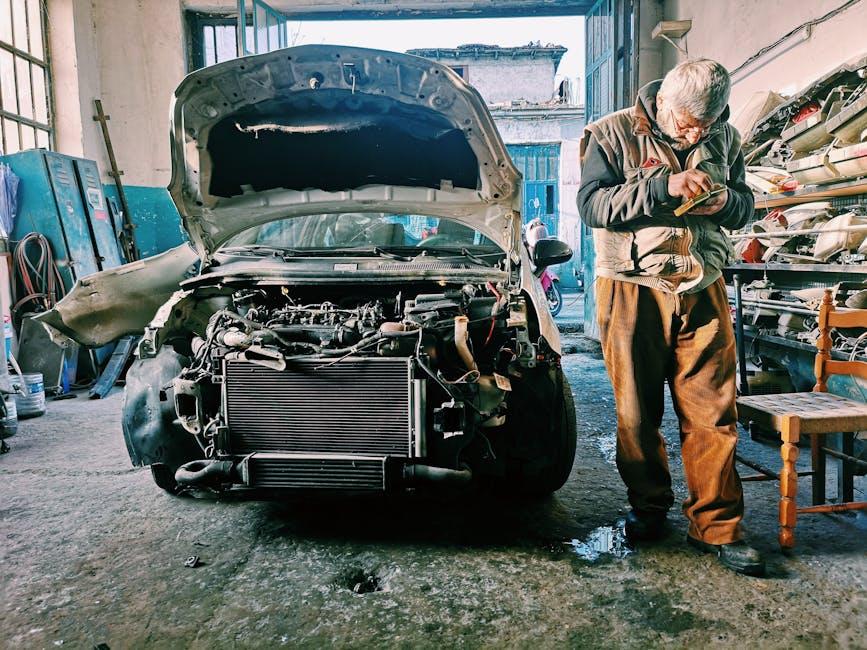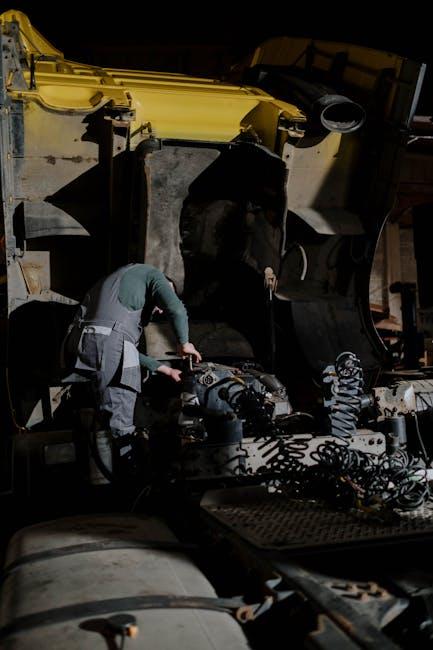Every vehicle is a carefully balanced symphony of parts working in harmony to deliver a smooth and safe ride. Among these components, struts play a pivotal role, quietly absorbing shocks and maintaining your car’s stability on the road. But like all hardworking elements, struts wear down over time, affecting your driving comfort and safety. Knowing how to replace struts on your vehicle isn’t just a handy skill—it’s a way to take control of your car’s performance and extend its lifespan. In this guide, we’ll walk you through the steps to confidently identify worn struts, select the right replacements, and perform the job with precision, turning a daunting repair into a manageable project. Whether you’re a seasoned DIYer or a curious beginner, understanding the art and mechanics of strut replacement empowers you to keep your vehicle running smoothly mile after mile.
Table of Contents
- Understanding the Role of Struts in Vehicle Performance
- Identifying Signs That Your Struts Need Replacement
- Selecting the Right Replacement Struts for Your Vehicle
- Preparing Your Workspace and Tools for the Job
- Step-by-Step Guide to Removing Old Struts Safely
- Proper Installation Techniques and Post-Replacement Checks
- Q&A
- In Conclusion

Understanding the Role of Struts in Vehicle Performance
Struts are essential components within your vehicle’s suspension system, acting as both a shock absorber and a structural support. They work to maintain tire alignment, enhance ride comfort, and stabilize handling, especially during cornering and braking. Without properly functioning struts, your vehicle may experience uneven tire wear, reduced steering precision, and increased body roll, all of which can compromise safety and driving enjoyment.
Understanding the mechanics of struts can illuminate why timely replacement is crucial. These components typically endure continuous stress, leading to gradual wear that might not be immediately noticeable. Some key signs of worn struts include:
- Excessive bouncing after hitting a bump
- Leaning or swaying during turns
- Increased stopping distance
- Visible oil leaks or damage to the strut body
| Symptom | Impact on Performance | Suggested Action |
|---|---|---|
| Uneven Tire Wear | Reduces tire lifespan and traction | Inspect alignment and replace struts if needed |
| Poor Handling | Compromises vehicle stability and driver control | Test suspension response and service promptly |
| Noise When Driving | Indicates worn or damaged struts | Diagnose and replace for safety |

Identifying Signs That Your Struts Need Replacement
Keeping an eye out for warning signs is crucial to maintaining your vehicle’s suspension system. If you experience excessive bouncing when driving over bumps or notice your car swaying during turns, these are clear indicators that the struts may no longer be performing at their best. Another red flag is uneven tire wear, often a subtle hint that the struts aren’t properly stabilizing the wheels, leading to irregular contact with the road. Additionally, if you hear strange clunking noises when going over rough terrain, it’s a strong suggestion that the strut components might be worn or damaged.
For a quick overview, here are common symptoms that shouldn’t be ignored:
- Extended braking distances indicating poor vehicle control.
- Oil leakage around the struts, suggesting internal seal failure.
- Visible physical damage like dents or rust on the strut body.
- Dashboard warning lights related to suspension or stability control.
| Symptom | What it Means |
|---|---|
| Unstable handling | Struts may have lost damping ability |
| Fluid on strut surface | Seal is leaking, outer casing compromised |
| Noises when driving | Loose or damaged internal components |
| Uneven tire wear | Suspension misalignment due to strut failure |

Selecting the Right Replacement Struts for Your Vehicle
Choosing the perfect struts for your vehicle involves more than just matching numbers — it’s about understanding the specific performance and comfort needs of your ride. Start by consulting your vehicle’s manufacturer specifications and consider the make, model, and year to ensure compatibility. Struts come in various types such as standard, heavy-duty, and performance, each tailored to different driving styles and conditions. Standard struts offer balanced comfort and control, ideal for daily driving, while heavy-duty struts are engineered for vehicles that often carry heavy loads or tow. Meanwhile, performance struts are designed to enhance handling and responsiveness, perfect for those who crave a sportier feel.
Additional factors to evaluate include the strut material quality, warranty, and customer reviews. Opting for struts with enhanced corrosion resistance can extend their lifespan, especially in regions with harsh weather. When in doubt, look for brands that provide clear warranties and have positive feedback from mechanics and vehicle owners alike. To assist your decision, here’s a quick comparison of strut types:
| Strut Type | Ideal Usage | Key Benefit |
|---|---|---|
| Standard | Daily commuting | Comfort & reliability |
| Heavy-Duty | Heavy loads & towing | Durability & strength |
| Performance | Sporty driving | Enhanced handling |

Preparing Your Workspace and Tools for the Job
Begin by clearing a spacious and well-lit area where you can work comfortably without distractions. A flat, stable surface such as a concrete garage floor is ideal, as it provides the necessary foundation to safely elevate your vehicle. Equip yourself with a sturdy jack, jack stands, and wheel chocks to ensure maximum safety throughout the process. Laying down a durable mechanic’s mat or thick cloth can also prevent dirt and grease from transferring to your clothing or tools.
Gather all necessary tools beforehand to keep your workflow smooth and efficient. Common essentials include socket wrenches, spring compressors, screwdrivers, and a torque wrench. Having an organized tool tray or magnetic parts holder nearby will prevent small components from being lost during disassembly. Below is a quick reference table of key tools and their primary function to help you prepare:
| Tool | Purpose |
|---|---|
| Jack & Jack Stands | Lift and secure the vehicle safely |
| Socket Set | Remove nuts and bolts |
| Spring Compressor | Safely compress coil springs on struts |
| Torque Wrench | Ensure bolts are tightened to manufacturer specs |
| Screwdrivers | Detach clips and minor fasteners |

Step-by-Step Guide to Removing Old Struts Safely
Before beginning the removal process, ensure your vehicle is securely lifted and properly supported with jack stands. Safety first: wearing gloves and protective eyewear will guard against unexpected debris or fluid leaks. Start by carefully removing the wheel to expose the strut assembly. Next, disconnect any attached components such as brake lines or ABS sensor wires, noting their positions for easy reinstallation. Keeping a clear workspace and organizing removed bolts and screws on a magnetic tray can prevent frustrating mishaps later on.
With the assembly exposed, loosen the upper mounting bolts inside the engine bay before tackling the lower fasteners connected to the steering knuckle. As you remove the final bolts, hold the strut firmly—these components can be surprisingly heavy. Avoid forcing the strut out; a gentle twist combined with steady force usually frees it without damage. Remember to inspect surrounding parts for wear, as replacing struts is an ideal opportunity to address any additional suspension concerns.

Proper Installation Techniques and Post-Replacement Checks
When installing new struts, precision and care are paramount to ensure longevity and safety. Begin by aligning the strut assembly with the vehicle’s mounting points without forcing or bending components. Use a torque wrench to tighten all bolts to the manufacturer’s specified settings—over-tightening can damage parts, while under-tightening compromises stability. Always replace worn or corroded mounting hardware to prevent future failures. Don’t forget to compress the strut spring safely using a spring compressor tool, which avoids injury and ensures the strut functions correctly once installed.
After installation, conduct thorough checks to verify everything is correctly assembled and operational. Here’s a handy checklist to follow:
- Visual Inspection: Confirm no parts are loose or misaligned.
- Bounce Test: Push down on the corner of the vehicle and observe the rebound to assess the strut’s dampening effect.
- Wheel Alignment: Schedule a professional alignment to ensure proper handling and tire wear.
- Road Test: Drive slowly over various surfaces to detect any unusual noises or vibrations.
| Check | Purpose | Ideal Result |
|---|---|---|
| Mounting Bolt Tightness | Secure connection | Within torque specs |
| Strut Spring Compression | Proper function and safety | Consistent tension, no gaps |
| Vehicle Rebound | Assess damping | Stops smoothly after 1-2 bounces |
Q&A
Q&A: How to Replace Struts on Your Vehicle
Q1: What exactly are struts, and why are they important?
A1: Struts are a key part of your vehicle’s suspension system. They combine the functions of shock absorbers and structural support for the springs. They absorb road shocks, improve handling, and help maintain tire contact with the road. Without functional struts, your ride can become bumpy, unstable, and unsafe.
Q2: How do I know if my struts need replacing?
A2: Common signs include excessive bouncing after hitting bumps, a noticeable clunking noise, uneven tire wear, poor steering response, or a sagging vehicle posture. If your car feels unstable or if you see oil leaking from the strut housing, it’s probably time for new struts.
Q3: Can I replace struts myself, or should I go to a mechanic?
A3: Replacing struts is a moderate to advanced DIY task. It requires jack stands, a spring compressor, and some mechanical know-how to avoid injury. If you’re comfortable with tools and follow safety steps carefully, it’s doable, but if you’re unsure, a professional mechanic can ensure the job is done safely and correctly.
Q4: What tools and materials will I need to replace my struts?
A4: You’ll typically need:
- A jack and jack stands
- Socket and wrench sets
- Spring compressor (crucial for safely handling coil springs)
- Penetrating oil for rusty bolts
- Torque wrench
- New strut assemblies or struts with compatible springs
Q5: What are the basic steps for replacing struts?
A5: The general process involves:
- Lifting and safely supporting the vehicle
- Removing the wheel and accessing the strut assembly
- Detaching the strut from the steering knuckle and control arm
- Compressing the coil spring and separating it from the old strut
- Installing the new strut with the spring (or as a full assembly)
- Reassembling everything and torquing bolts to specs
- Repeating on the other side if necessary, followed by a professional wheel alignment
Q6: How long does it usually take to replace struts?
A6: On average, an experienced DIYer might spend 1.5 to 3 hours for a pair of struts, while a professional mechanic can often do it faster. Your vehicle’s model and strut design can influence the time.
Q7: Do I need to get a wheel alignment after replacing struts?
A7: Yes, absolutely. Strut replacement can affect suspension geometry and wheel alignment. A professional alignment ensures proper tire wear and handling performance after the job.
Q8: Can I replace just one strut, or should I replace both?
A8: It’s strongly recommended to replace struts in pairs—both front or both rear—to maintain balanced handling and consistent ride quality.
Q9: What are some safety tips to keep in mind?
A9: Always use a quality spring compressor when working with coil springs to avoid serious injury. Never attempt to compress springs without the right tool. Make sure your vehicle is securely supported with jack stands, and double-check all torque settings before lowering your car.
Q10: How can I prolong the life of my new struts?
A10: Regularly inspect your suspension components, avoid potholes and rough terrain when possible, keep your tires properly inflated, and get your alignment checked periodically. Good maintenance can keep your struts working smoothly for many miles.
In Conclusion
Replacing the struts on your vehicle may seem like a daunting task at first, but with patience, the right tools, and a clear step-by-step approach, it becomes a manageable and rewarding DIY project. Not only do fresh struts improve your ride quality and handling, but they also enhance your overall safety on the road. So next time you notice that telltale bounce or hear a clunk in the suspension, remember—you have the knowledge to tackle the repair yourself and keep your vehicle running smoothly for miles to come. Drive confidently, knowing you’ve taken a hands-on role in maintaining your car’s performance and comfort.

